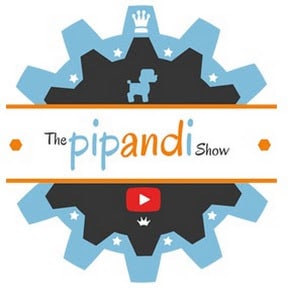The marketer’s adage “The money is in the list” is (mostly) solid advice. When I launch a product, a significant portion of sales comes from my email list every time. I take good care of my email list, and they take care of me.
On a recent launch, I found 53% of sales came from my email list, despite the fact that my email list is less than 1/6th the size of my social media following which is over half a million.
Pace! The metric that matters
More important than the total number of people on your email list today is the pace at which your list is growing. I would be far more interested in buying a site with a list of 10,000 that is growing by 100 new signups per day than a business that has 15,000 signups and is only growing by a dozen a day.
Why? Because a year from now, the first business will have a list twice the size of the second business. Pace is the number that really matters, and it’s pace that I’ve always monitored in my own business.
So before we move on to the actual tips that I’m using to grow my list, take a look at your pace. Go find out what it is. How many email opt-ins did you have yesterday? Yesterday, I added 227 people to my email list. That puts me on track to add 78,110 people to my email list in 2015.
Understanding your pace metric is important to keep you on track. Usually, when someone asks me how I built a list so quickly, they want to know the silver bullet that I used. There isn’t one. I don’t think I have ever added more than 500 people a day to my email list (except for during a launch). All I pay attention to is my pace, and I can tell if I’m on track to meet my goals a year from now. No silver bullets necessary.
Why Total Subscribers is a Dangerous Metric
At one point, I had built an email list of 40,000 subscribers. I was sitting pretty comfortable. But I ran several reports on my subscribers and found something pretty shocking. Despite an open rate of 20% (which is very respectable), there were another 25% of my subscribers who hadn’t opened an email from me in 6 months! Six months!
Those emails were almost certainly being sent to the spam box. That, or the email account was no longer active, or the subscriber really headed my headlines 🙂
If I had established a sense of pride in my large list of 40,000, I would have shrugged and walked away from this issue, but I didn’t. I only care about the pace of growth, not the total number of subscribers. Because of that, it was an easy decision for me to remove these 16,000 subscribers.
Removing the subscribers was an excellent choice. When Gmail and other webmail providers see that a large number of my newsletters go to spam and nobody ever notices they were missing, it is a signal to the webmail provider that the message is not important–making it more likely that my other readers on that webmail client will get their newsletter sent to spam as well.
Obviously, the total number of subscribers matters tremendously, but only if we are talking about active subscribers. And how do you get a large list of active subscribers? Monitor your pace–every day.
Right now, my email list is about 80,000 strong. That’s great, but I’m on pace to nearly double that this year because of some changes I’ve made to the way I grow my list.
The Three Simple Changes that Doubled My Pace
First, I changed my email provider–great decision!
I was an Aweber customer for over 3 years. I am not an Aweber fan and wasn’t a fan even when I was their customer, but they were the best of the worst. In short, I didn’t like Aweber for three reasons: #1 They charge too much, #2 They charge by total subscribers–even inactive and UNSUBSCRIBED people, but they don’t provide a way for you to manually bulk delete your unsubscribed list without calling in. It’s pretty obvious they do this so they can charge you more and annoy you more. #3 They make it nearly impossible to have a single opt-in list.
A double opt-in list is the most common. You enter your email address on a website and then they send you a link in your email you have to click to be subscribed. A single opt-in list works by having someone add their email address on the website only.
Double opt-in has been sold to us by the email marketing companies like Aweber. They want to be certain that the email address is valid because if a spammer gets an account and sends spam messages to people who haven’t subscribed, then the webmail companies blacklist the server sending that email. That means the email marketing company can’t get the messages of their paying clients delivered.
There is good reason for the double opt-in system, but I believe there’s a better way.
I switched my email service to MadMimi. MadMimi makes it very simple to use single opt-in lists. They charge less money. The interface is 100x cleaner and easier to use, and their support has been very helpful when I’ve needed them. MadMimi was recently acquired by Godaddy.
Second, I got an opt-in box that actually works
I have tried just about every email optin-box plugin out there. I used Opt-in Skin for a long time, but it was always a bit clunky. Some did better than others, but over all they all performed similarly.
I switched over all my sites to Optin Monster about a year ago. Optin Monster is a fantastic WordPress plugin with one killer feature: exit intent.
Exit intent means that the optin box does not pop up as soon as you get to the page, or at any point while you’re reading an article. It only shows up when you rapidly scroll your mouse up to the top of the page (presumably to hit the back button and leave the site). So the pop up only shows up for people that are about to leave anyway. If they are about to leave the site, chances are very low they’ll ever visit again, so you might as well see if you can hook them on the email list.
Optin Monster is my best buddy. Over 95% of my email signups happen because of this pop-up.
Third, I made an email list that’s actually worth subscribing to
The #1 thing that kept me from building a large list early on in my business is that I didn’t really have anything to share on my email newsletter. I would email people when we were having a sale, but I knew that wasn’t really serving them. I was just shoving ads down their throats.
I do send advertising emails out when I launch a product, but that’s the only thing I was sending out.
About a year ago I finally turned the corner. I came up with an idea for email content that would be (1) worth subscribing to, and (2) totally different from what I already have available on the website.
My email list now shares one of my photos, and a full tutorial on how I made the photo. I even do something that very few professional photographers do–I share the original, unretouched photo as well as the completed, Photoshopped photo. For my photography blog, this has been very very successful. Find out what valuable emails you can send out that is unique content from what you already have on your website, and you’re on track to making a great newsletter.








